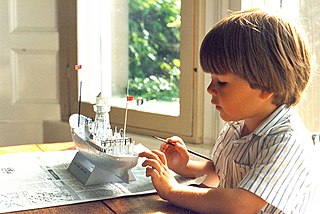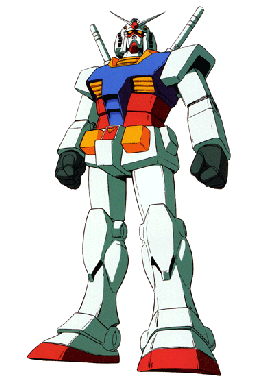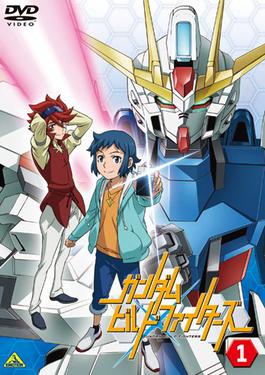Related Research Articles

Mobile Suit Gundam, also retrospectively known as First Gundam, Gundam 0079 or simply Gundam '79, is an anime television series, produced and animated by Nippon Sunrise. Created and directed by Yoshiyuki Tomino, it premiered in Japan on Nagoya Broadcasting Network and its affiliated ANN stations on April 7, 1979, and lasted until January 26, 1980, spanning 43 episodes. It was the first Gundam series, which has subsequently been adapted into numerous sequels and spin-offs. Set in the futuristic calendar year "Universal Century" 0079, the plot focuses on the war between the Principality of Zeon and the Earth Federation, with the latter unveiling a new giant robot known as the RX-78-2 Gundam piloted by the teenage civilian mechanic Amuro Ray.
Gundam is a Japanese military science fiction media franchise. Created by Yoshiyuki Tomino and Sunrise, the franchise features giant robots, or mecha, with the name "Gundam". The franchise began on April 7, 1979, with Mobile Suit Gundam, a TV series that defined the "real robot" mecha anime genre by featuring giant robots called mobile suits in a militaristic setting. The popularity of the series and its merchandise spawned a franchise that includes 50 TV series, films and OVAs as well as manga, novels and video games, along with a whole industry of plastic model kits known as Gunpla which makes up 90 percent of the Japanese character plastic-model market.

Mobile Suit Gundam: Char's Counterattack is a 1988 Japanese anime science fiction film directed and written by Yoshiyuki Tomino. It is set in the Universal Century timeline of the Gundam franchise. Featuring the talents of Shūichi Ikeda, Toru Furuya, Hirotaka Suzuoki, Maria Kawamura, Nozomu Sasaki, Kōichi Yamadera, among others, it focuses on Char Aznable's attempt of genocide on the planet Earth by pushing the asteroid called Axis into a collision with the planet. As a result, Char's rival from the Earth Federation Amuro Ray tries to defeat him in combat and avoid a slaughter in the process.

Turn A Gundam, also stylized as ∀ Gundam, is a 1999 Japanese mecha anime series produced by Sunrise, and aired between 1999 and 2000 on Fuji Television and other FNS stations. It was created for the Gundam Big Bang 20th Anniversary celebration, and is the eighth installment in the Gundam franchise. It was later compiled in 2002 into two feature-length films entitled Turn A Gundam I: Earth Light and Turn A Gundam II: Moonlight Butterfly.

Bandai Co., Ltd. is a Japanese multinational toy manufacturer and distributor headquartered in Taitō, Tokyo. Its international branches, Bandai Namco Toys & Collectables America and Bandai UK, are respectively headquartered in Irvine, California, and Richmond, London. Since 2006, Bandai is the toy production division of Bandai Namco Holdings, currently the world's second largest toy company measured by total revenue. Between 1981 and 2001, Bandai was a manufacturer of video game consoles.

A scale model is a physical model that is geometrically similar to an object. Scale models are generally smaller than large prototypes such as vehicles, buildings, or people; but may be larger than small prototypes such as anatomical structures or subatomic particles. Models built to the same scale as the prototype are called mockups.

A plastic model kit,, is a consumer-grade plastic scale model manufactured as a kit, primarily assembled by hobbyists, and intended primarily for display. A plastic model kit depicts various subjects, ranging from real life military and civilian vehicles to characters and machinery from original kit lines and pop fiction, especially from eastern pop culture. A kit varies in difficulty, ranging from a "snap-together" model that assembles straight from the box, to a kit that requires special tools, paints, and plastic cements.
The Zaku is a fictional line of "Mobile Suits" or mecha from Mobile Suit Gundam, part of the fictional universe of the Universal Century, where they are the Principality of Zeon's most commonly fielded Mobile Suits. The most widely known model is the MS-06 Zaku II series. It is redesigned by Kunio Okawara based upon the earlier draft by the series director Yoshiyuki Tomino, in which only the name was kept. The Zaku II has seen various redesigns and variants for hundreds of pieces of merchandise, and the Japanese post office has two stamps with Zaku IIs on them. The Zaku's aesthetic can be seen in more symbolic homages in the Gundam mythos, such as the GINN and ZAKU Warrior from Mobile Suit Gundam SEED, the Busshi from Mobile Fighter G Gundam, and the Jenice from After War Gundam X.

The RX-78-2 Gundam is a fictional manned robot (mecha), introduced in 1979 in Yoshiyuki Tomino's and Sunrise's anime series Mobile Suit Gundam. In the series, it is a prototype weapon for the Earth Federation when it falls into the hands of Amuro Ray, the son of its designer in story, who goes on to pilot it in the Earth Federation's war against the Principality of Zeon.
SD Gundam is a media franchise that spawned from the Gundam franchise. SD Gundam takes the mecha from Gundam and expresses them in super deformed and anthropomorphic style.
A garage kit (ガレージキット) or resin kit is an assembly scale model kit most commonly cast in polyurethane resin.
A poly-cap is a small rubber polyethylene bushing used to create smooth joints, or to keep something in place without glue in scale-models. In model kit descriptions, they are sometimes referred to under the material acronym PE. They are usually found on kits such as those by Tamiya and Bandai who have employed them for a long time.

Mobile Suit Gundam Unicorn is a novel by popular Japanese author Harutoshi Fukui. The novel takes place in Gundam's Universal Century timeline. Character and mechanical designs are provided by Yoshikazu Yasuhiko and Hajime Katoki, respectively.
Mecha, also known as giant robot or simply robot, is a genre of anime and manga that feature mecha in battle. The genre is broken down into two subcategories; "super robot", featuring super-sized, implausible robots, and "real robot", where robots are governed by realistic physics and technological limitations.

Model Suit Gunpla Builders Beginning G is an anime produced by Sunrise to celebrate the 30th anniversary of the Gundam plastic model kits. It was directed by Kou Matsuo and written by Yousuke Kuroda, and features character designs by Kaichiro Terada. The show was originally broadcast on BS11 and streamed on the Internet from August 15, 2010 to December 19, 2010 with 3 15-minute episodes before being released on both DVD and Blu-ray on December 22, 2010. Unlike other Gundam titles, Gunpla Builders Beginning G takes place in a present-day timeline.
Gundam Plastic models, Gundam Plamo, or Gunpla are model kits depicting the mecha machinery and characters of the fictional Gundam multiverse by Bandai Spirits.

Gundam Build Fighters, often abbreviated as GBF, is a 2013 Japanese science fiction anime television series based on Sunrise's long-running Gundam franchise. The series is directed by Kenji Nagasaki of No. 6 and written by Yōsuke Kuroda of Mobile Suit Gundam 00. Character designs were done by both Kenichi Ohnuki and Suzuhito Yasuda. The series was first unveiled under the name "1/144 Gundam Mobile" project by Sunrise, before its official announcement. In contrast to other Gundam series, Gundam Build Fighters focuses on the Gundam model (Gunpla) aspect of the franchise.
The giant robot anime franchise Gundam is a popular culture icon in Japan.

Plamo-Kyoshiro is a manga series created and written by Hisashi Yasui and illustrated by Koichi Yamato. Part of Sunrise's Gundam Franchise, it was first serialized in Kodansha's Shōnen magazine Comic BomBom from August 20, 1982 until December 17, 1986, compiling up to 15 tankobon volumes.

Gundam Build Divers. often abbreviated as GBD. is a Japanese science fiction anime television series produced by Sunrise, a spiritual successor to the 2013 anime Gundam Build Fighters, based on the long-running Gundam franchise. It is directed by Shinya Watada and written by Noboru Kimura with character designs by Juri Toida. It was first teased in December 2017 under the title "Gundam Build Next Battle Project" until its official reveal in The Gundam Base Tokyo on February 2, 2018. It premiered on all TXN network stations in Japan on April 3, 2018. Unlike the previous series, which focuses on the Gundam model (Gunpla) aspect of the franchise, Gundam Build Divers focuses on a virtual reality massively multiplayer online game in terms of themes and battles.
References
- ↑ Lauren (2014-09-07). "How to Fix Broken Gunpla". Gunpla 101. Retrieved 2023-09-12.
- ↑ Lauren (2021-01-20). "Essential Tools for Gunpla Building". Gunpla 101. Retrieved 2023-09-12.
- ↑ Lauren (2016-12-29). "The Best Tools for Gunpla, Ranked". Gunpla 101. Retrieved 2023-09-12.
- ↑ "BANDAI SPIRITS Strengthened Its Productive Capacity for Models like GUNPLA with the Bandai Hobby Center's New Building Opening Today! | GUNDAM.INFO". GUNDAM.INFO | The official Gundam news and video portal. Retrieved 2023-09-20.
- ↑ Ashley, Clayton (2021-10-22). "How I got into Gunpla, building plastic Gundam models (and you can, too)". Polygon. Retrieved 2023-09-12.
